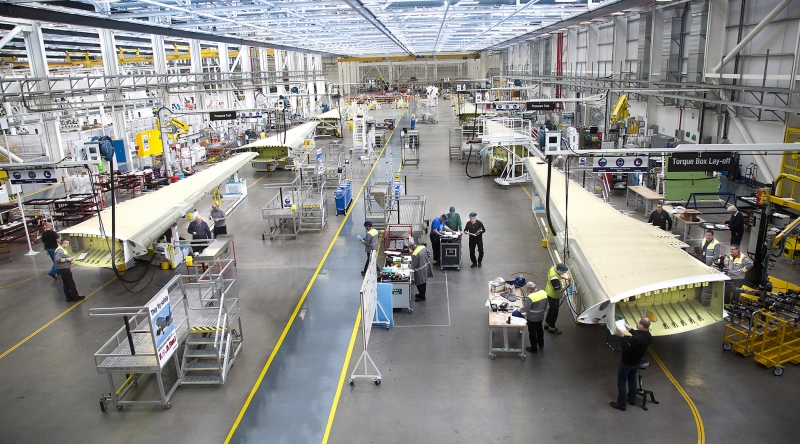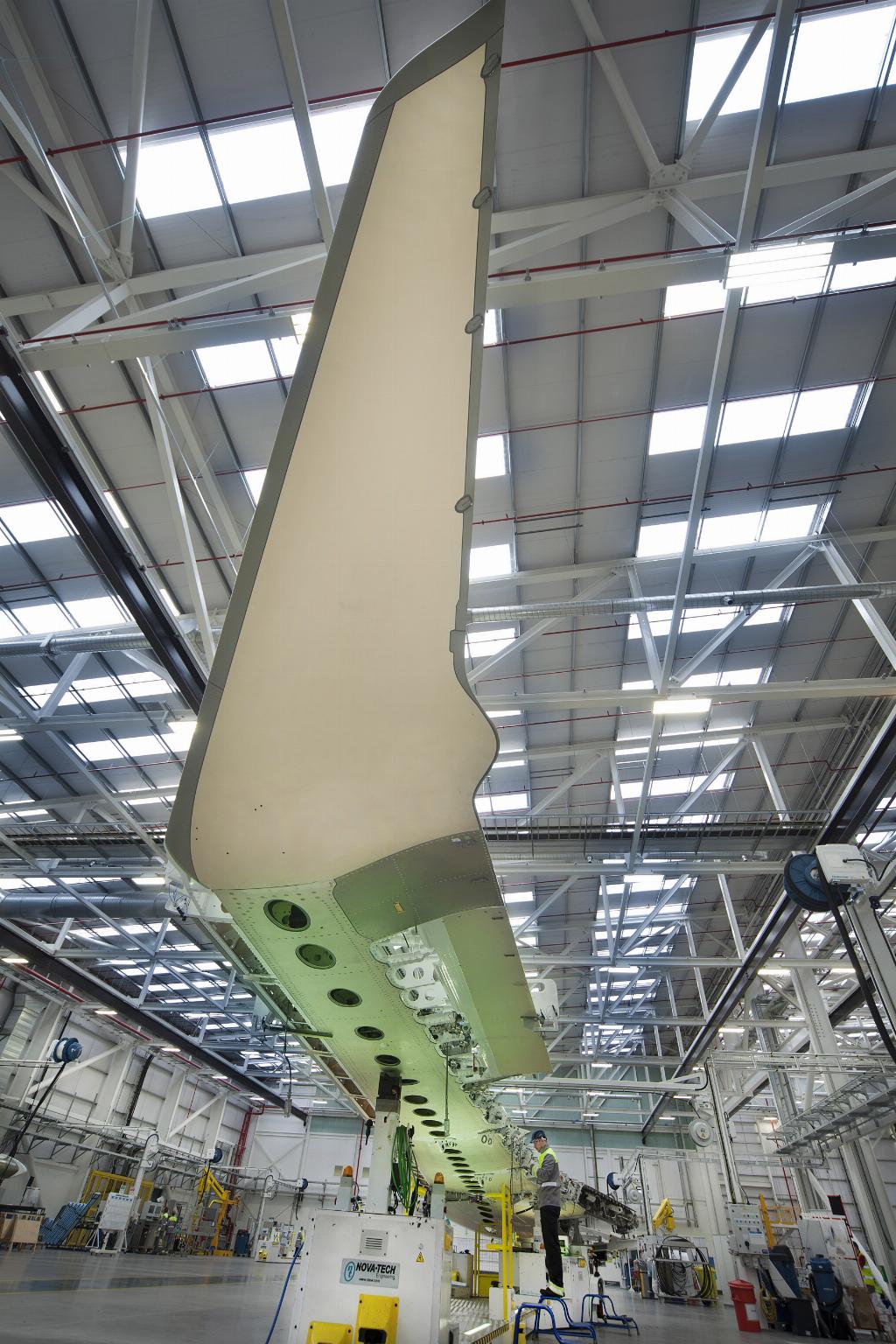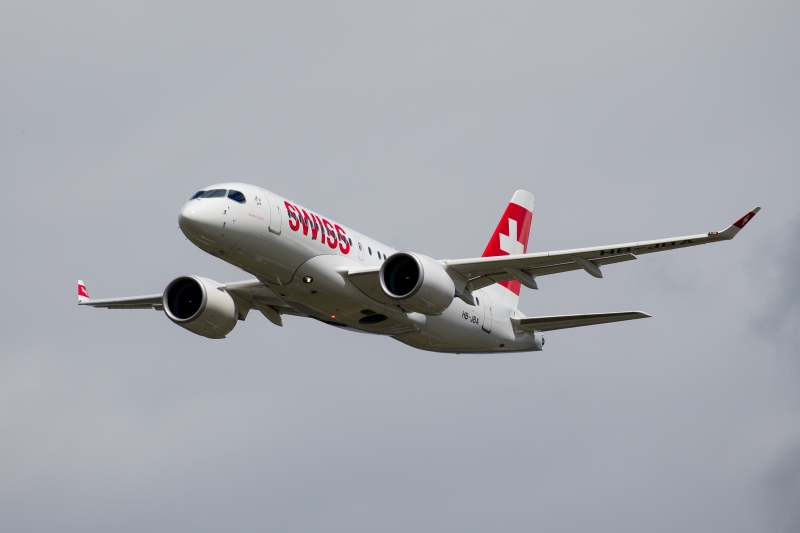C Series earns its wings

Technical editor, Dr Neil Calder gets the wind beneath his wings to discuss the latest developments regarding the Bombardier CS100’s introduction into service, and particularly its Belfast manufactured composite wings.
Swiss International Air Lines, the launch customer for Bombardier’s CS100, made very strong statements about its satisfaction with the performance of this aircraft at the 2016 Farnborough Airshow launch event to mark its entry into revenue service on 15th July.
The delivery on promises of improvements in specific fuel consumption is dependent primarily upon advanced engine and structures technology, with a large part played by the wing performance. This has taken some decades of very deliberate technology and production capability development.
Gavin Campbell, Bombardier’s director, engineering and technology development in Belfast, succinctly describes the wing as “successful!” The structure of the wing’s main load bearing torque box is carbon fibre spars and integrally stiffened upper and lower wingbox covers, creating a tapered cantilever beam. All these primary structures are resin transfer infused (RTI) carbon fibre. C Series is the first aircraft into the market with this technology, which is different from other carbon fibre wings in that they all use prepreg material.

The wing torque box is 15m long, with one piece structures throughout that entire length. This is far from the size limitation for this production technology, though. With the alternative prepreg material, managing the out-of-fridge life would be an issue; however, this doesn’t apply to the dry fibre construction method which is very predictable, consistent and consequently delivers high production quality. A large part of the technology prove-out was demonstrating that Bombardier could go to a component of this size.
The top and bottom wing skins are integrally stiffened with stringers laid up in proprietary tooling which holds the dry fibre stringer preforms securely against the skin and are co-injected with resin at the same time as the skins. This is one of the significant advancements in composites processing technology, which has made these structures viable. The process is based on the Bombardier patented infusion technology, but there are a number of different technologies which have been developed together and brought together in these parts. Infusion provides the core technology, but this has a number of variations and tweaks addressing different aspects of the structure to make the whole portfolio work together.
Taking complete control
Although many aerospace sector players aspire to move away from their reliance on autoclave curing, this infusion process does not take that step.
Campbell explains: “We are convinced that this is the key to delivering a high quality product from a highly repeatable process. There is talk from time to time of the economies of moving out of the autoclave curing, but Bombardier isn’t convinced about this. In aerospace, particularly when you want a robust, repeatable, quality process, you need the high degree of control of temperature and pressures afforded by curing in autoclaves to deliver that.”
There are other more tactical aspects of how they optimise the design: knowing that they have a highly-controlled and highly repeatable process means that they have been able to optimise the structural design better. They don’t have to build in as much reserve factor, which in some cases means that they have been able to reduce the number of plies and the amount of material in the wing by reducing tolerance factors. Working with broad tolerance bands on material performance can result in a lot of excess weight to make sure that even with the minimum thickness the structure is still able to exceed the minimum strength requirements.
The wing ribs are metallic, in conventional aerostructure alloys similar to other current composite wing designs by Airbus and Boeing. However, Bombardier has significantly reduced the amount of mechanical fastening which goes into the wing through the complete integration of the stringers with the skins, so any fastening is around securing ribs to the skins and spars.
In tracking the origins of this capability from the late 90s, a whole range of collaborative R&D projects at national and European level have been involved, plus a number of try-outs for the technology through stage development structures like the fully certified production of CRJ outboard flaps and flight control surfaces. The RTI technology has been used on these earlier programmes on a smaller scale, as part of the unfolding of the technology strategy for scaling up and de-risking technology progressively and demonstrating to both customers and regulators that these products can be used successfully within the marketplace.
A methodical approach
Within a programme of this magnitude, a very structured and methodical process of mitigating risk must be followed. Campbell expands: “You can’t just treat it as an exercise in developing technology: this is a series of rational business decisions in de-risking the technology and opening up the envelope by demonstrating increasing size and complexity of components together with increasing production rates.”

Drivers for the C Series wing were mass, performance, cost within a multidimensional challenge. For the programme overall, customers are most interested in the overall cost of ownership, comprising upfront acquisition as well as operating costs through fuel burn efficiency and ongoing maintenance requirements. The C Series programme is delivering more than 20% improvements in fuel burn compared to current competition, and even 10% over re-engined aircraft. Composite structures are well known for their excellent fatigue life, which is opening out inspection and maintenance intervals.
Certifying and bringing this in service has been a major achievement. It’s been done with flying colours with many high compliments from the FAA when they came to do the certification and to inspect the production process in Belfast, particularly in how Bombardier certified the product, manufactured it and controlled the manufacture of it. This was cited as a really good example of certifying modern technology and supported the perception of Bombardier in a sector leadership position. The Belfast team take a lot of pride in that.
This is the first major new civil aerospace programme in its class for almost 30 years, since the introduction into service of the A320, as other airframers are offering extended variants and the developments from legacy engineering. Bombardier have not had the luxury of being able to rely on grandfather certification and have therefore had to take a clean sheet approach involving every nut and bolt: every ply and drop of resin on the C Series wing has had to go through a rigorous certification to current regulations. It is only now that many within the industry are realising the magnitude of this task, and the justification for the seemingly lengthy gestation period for this product.
The C Series composite wing project represents a £520 million investment in Belfast industry, the largest ever single inward investment in Northern Ireland. The £134m of public funding in this has an element of repayable loan (£113m), from which the UK government should see a significant return, and the remainder was grant for technology development.
The only way is up
The Belfast wing facility will involve some 800 jobs at full production rates, which are thought to be in the region of 90-120 aircraft sets per year by 2020. A further 2,000 jobs will be required within the supply chain, mostly for the wing systems equipping and structures outside the torque box to create leading and trailing edge features such as flaps, and for the winglets supplied by GKN.

So, what next? Campbell points to a focus on rate increase. Bombardier has some very excited launch customers in Swiss already for the CS100 and Baltic expected in September for the larger CS300 variant, but need to deliver on ramp up schedules and getting up to rate production. The same wing aerostructure technology was to have been used for the now cancelled Learjet 85 programme, and will remain within the Bombardier capability portfolio, confirming Belfast as the centre for composites activity within Bombardier globally.
There is now a total of 358 firm orders across the CS100 and CS300, many of them coming this year as the project gains commercial and production momentum. With a long journey before the project reaches profitability, it isn’t going to be plain sailing for the C Series, but at least it now has the wing technology to compete in the crowded 100-150 seat sector.













